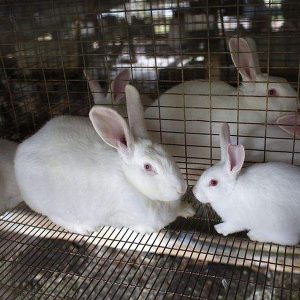Description
American Rabbit for sale
American Rabbit Breed History/Origin
The American Rabbit was developed in 1917 by Lewis H. Salisbury of Pasadena, California. While he never said which breeds he used to develop the American rabbit, it is generally believes that he crossed a few blue European rabbits such as the Vienna, Blue Imperial, Flemish Giant and Beveren. Back in 1910, the American rabbit used to be called the “German Blue” and a second variety of this rabbit, the white, was added in 1925. The “German Blue” changed into “American” shortly after World War I.
After WWII, interest in this rabbit declined as commercial rabbit breeders sought to find a faster-growing rabbit, and those who wanted rabbits for show purposes wanted a smaller, cuter rabbit or one with interesting markings. Unfortunately, this breed became the rarest breed in the United States by the early 2000s with a mere 200 known to exist. Thankfully, the American Livestock Breeds Conservancy became aware of this problem and undertook measures to ensure the breed’s survival.
The American Rabbit comes with either a white or blue coat.
Overall Description
The American rabbit has a semi-arch body type, which means the top line of the body (when viewing them from the side) doesn’t immediately rise behind the ears but flattens and curves upward at the midsection. Their ears are rather narrow, proportional in length and tapered. They can weigh anywhere from 9-11 lbs. once fully grown, so they are a medium to large sized rabbit.
Coat
 This bunny’s coat is known to be very attractive. Should you decide to have this rabbit as a pet, expect their fur to be soft, fine and have a silky texture to the touch. Both types of American rabbits (white and blue) have short, flyback fur (flyback means the coat will go back into place after being petted backwards).
This bunny’s coat is known to be very attractive. Should you decide to have this rabbit as a pet, expect their fur to be soft, fine and have a silky texture to the touch. Both types of American rabbits (white and blue) have short, flyback fur (flyback means the coat will go back into place after being petted backwards).
To keep their coat dirt-free, make sure to groom your rabbit as necessary and under no circumstances should you give them a bath, as this stresses your rabbit out and can cause them to go into cardiac arrest. Bathing them also destroys many of the natural qualities for their fur. Don’t worry; rabbits are relatively clean creatures and can take care of their own bathing requirements.
When your American rabbit molts, be aware of how often you brush them. If they are only shedding a little bit, keep your brushing to a minimum. Be sure to increase the amount of brushings depending on how much they shed. Remember that like dogs, rabbits also have heavier shedding periods during particular times of the year.
Colors
The white American rabbit has white fur and red-colored eyes. The “Blue” American rabbit is a dark grey color
Care Requirements
Most rabbits are immaculately clean, and since washing them is an absolute no-no, groom your bunny with a brush a few times a month to keep their fur in tip-top shape.
When it comes to buying an enclosure for your rabbit, you have quite a few options. You can opt to have an indoor rabbit cage or purchase a dog crate and add some nifty bunny-friendly modifications, which is great for apartment dwellers. If you have a little bit more room outdoors or even have your own fenced backyard, you can purchase or build your own rabbit hutch or even a rabbit shed! But whenever you have an outdoor enclosure for your rabbit, always be aware of outdoor temperatures, how much sun your rabbit is exposed to and if there are any local predators you should be wary of (racoons, birds, coyotes, etc).
Indoor rabbits will no doubt have a deep connection with their owner, especially if they take the time to play with their little hoppers. Rabbits benefit from having lots of both indoor and outdoor playtime to stretch their legs and have a great time with their human friends. Many rabbits have different places they like to be petted, however most enjoy being stroked on their cheeks and forehead. If your rabbit likes this, they will more than likely put their head on the ground and close their eyes blissfully!
In terms of food, rabbits will enjoy a diet comprised mostly of pellets and hay (about 70 percent). Adult rabbits will eat about 1/4 cup of high-fiber pellets every day for every 5 pounds they weigh. They also enjoy fresh fruits and vegetables including carrots, watercress, red or green lettuce, celery, mango, pear, peach, and much more.





Reviews
There are no reviews yet.